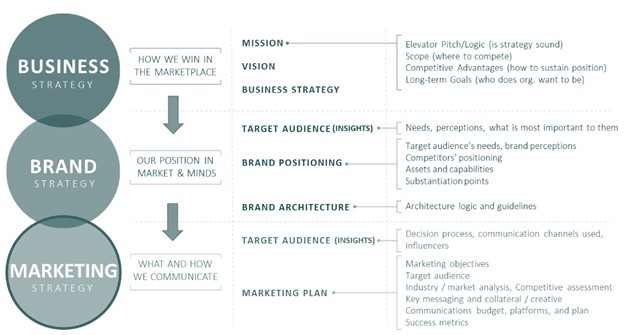Updated: Dec. 15, 2025
Originally Published: Feb. 13, 2022
How do brand strategy and marketing strategy differ? Do they overlap at all? If so, how? Or are they really the same thing with different names?
The short answer: They’re distinctly different, but equally important to your long-term business success.
What Is Brand Strategy?
A search of the term “brand strategy” yields an overwhelming number of conflicting definitions. Let’s cut through the confusion and think about brand strategy as a long-term plan for positioning your company to positively influence public and/or industry perception of your business. That positive perception then helps you achieve your business goals.
Common elements of formal brand strategies act as “guardrails.” That is, they influence all aspects – marketing, communications, operations – of the effort to shape perception of your business. Those elements are:
- Brand Architecture: The structure of brands within your company and how they are related to, and differentiated from, each other. Most brands take on one of four brand architectures: branded house, sub-brands, endorsed brands or house of brands.
- Brand Essence: The heart and soul of your brand – the fundamental nature or quality at the core of all your services or product categories.
- Brand Personality: The set of human characteristics associated with your brand.
- Brand Position: The conceptual place you want to own in the minds of your target customers. When customers and prospectives think of your brand, you want them to reflexively associate it with the business benefits that you have defined. An effective brand position maximizes your company’s relevance to your customers and gives you a distinct competitive advantage.
- Brand Promise: A succinct statement that outlines the unique value and benefits clients or customers can expect when doing business with you, for example: high standards of ethics and courtesy, sincere interest in your success, quick resolutions of any errors or misunderstandings.
- Brand Tagline: A short, memorable phrase that sums up the overall benefits of your products or services and tells your target audience how they will feel if they do business with you and are always positive. For example, think of Nike’s “Just Do It” tagline or State Farm’s “Like a Good Neighbor, State Farm Is There.”
- Brand Voice: Are you fun and informal? Professional and serious? Warm and down-to-earth? A thoughtfully chosen and developed overall brand voice allows you to speak consistently across all media.
Good brand strategy combines current brand perception and market opportunity with a deep understanding of your customers’ needs and problems. Good brand strategy builds confidence that your company has the unique means and position to meet those needs and solve those problems. This often requires several months of research and analysis.
We’ve found that many companies skip that research and strategy development – often because they don’t realize that they need it. Instead, they dive right into visual branding – logo, fonts, imagery, color palettes, iconography, etc. Without the guidance of knowledge and overall strategy, your visual identity is really just a guess. Brand strategy should always guide your visual brand identity. (Learn more about why a strategic approach to visual brand identity matters.)
Additionally, part of solid brand research is identifying all current brand touchpoints to ensure you're creating a consistent experience for customers. By conducting a thorough brand audit and identifying all the points at which a customer interacts with your company, brands can ensure that every aspect of the customer journey is designed to make their experience as seamless and straightforward as possible.
Identifying and prioritizing all brand touchpoints also enables brands to effectively communicate their values and message consistently across different channels and interactions. By understanding and reviewing all brand touchpoints, you can tailor your marketing activities to meet the needs and expectations of your customers, ultimately leading to increased satisfaction and loyalty.
What Is Marketing Strategy?
Brand strategy is all about who you are. Marketing strategy is all about how and what you communicate.
Always ground your messaging in your brand strategy. Let’s say you’re a manufacturing marketer. One company goal is to launch a new product and sell 500 units by mid-year. You gear your marketing plan toward meeting that objective within that timeframe. Define your target audiences and determine the best channels for reaching them. Determine what you want them to do, and craft calls to action that prompt them to do it. Build and execute your marketing plans to hit your objectives. Measure the results.
The marketing strategy outlined above rises from the foundation of your brand strategy – your brand voice, personality, brand architecture, and overall positioning.
This graphic nicely illustrates the flow:

Source: AMA Boston
A Real-Life Example
If all this seems too conceptual, here’s an informal example to distinguish between brand and marketing strategy.
I’m a huge Honda fan. I get warm, fuzzy feelings when I think about Honda. Really! Hondas are reliable, high quality, comfortable and loaded with customer-focused features. That’s branding.
Over time, I’ve purchased several Hondas, including an Odyssey, a Pilot, and a CR-V.
- At the time we purchased our Odyssey, it met the needs of our growing young family. I really didn’t want a mini-van – it just seemed so nerdy and made me feel so old! But Honda’s marketing focused on both the kid- and parent-friendly features the car offered and somehow made the idea of young parents driving a minivan seem cool. I was sold. That was marketing.
- As my kids got older, the Pilot appealed to my sense of adventure and desire for a more sophisticated car (one that doesn’t scream “I have little kids!”). But I didn’t want to lose the comfort and customer-focused features I expect from Honda. The third-row seat to accommodate carpooling without needing a mini-van won me over. Genius marketing.
- I recently purchased a CR-V. I no longer needed as much room as the Pilot, but I still wanted the comfort and safety of an SUV and the reliability and quality of a Honda. I saw an ad for a great financing rate, and I jumped. Marketing.
I’ve never had a Honda I didn’t like. I’m officially a loyal Honda customer. (And no, Northwoods isn’t getting paid for this very unofficial endorsement!) I might buy a different model, but I doubt I’ll ever buy another brand.
Final Thoughts
Your business strategy should lay the foundation for your brand strategy, which in turn guides your marketing strategy. While marketing brings customers to your door, an effective brand strategy keeps them coming back. Together, business, brand and marketing strategy drive growth, profitability and loyalty.
If you need assistance developing your brand strategy, Northwoods can help! Learn more about our brand strategy services and request a consultation today.






